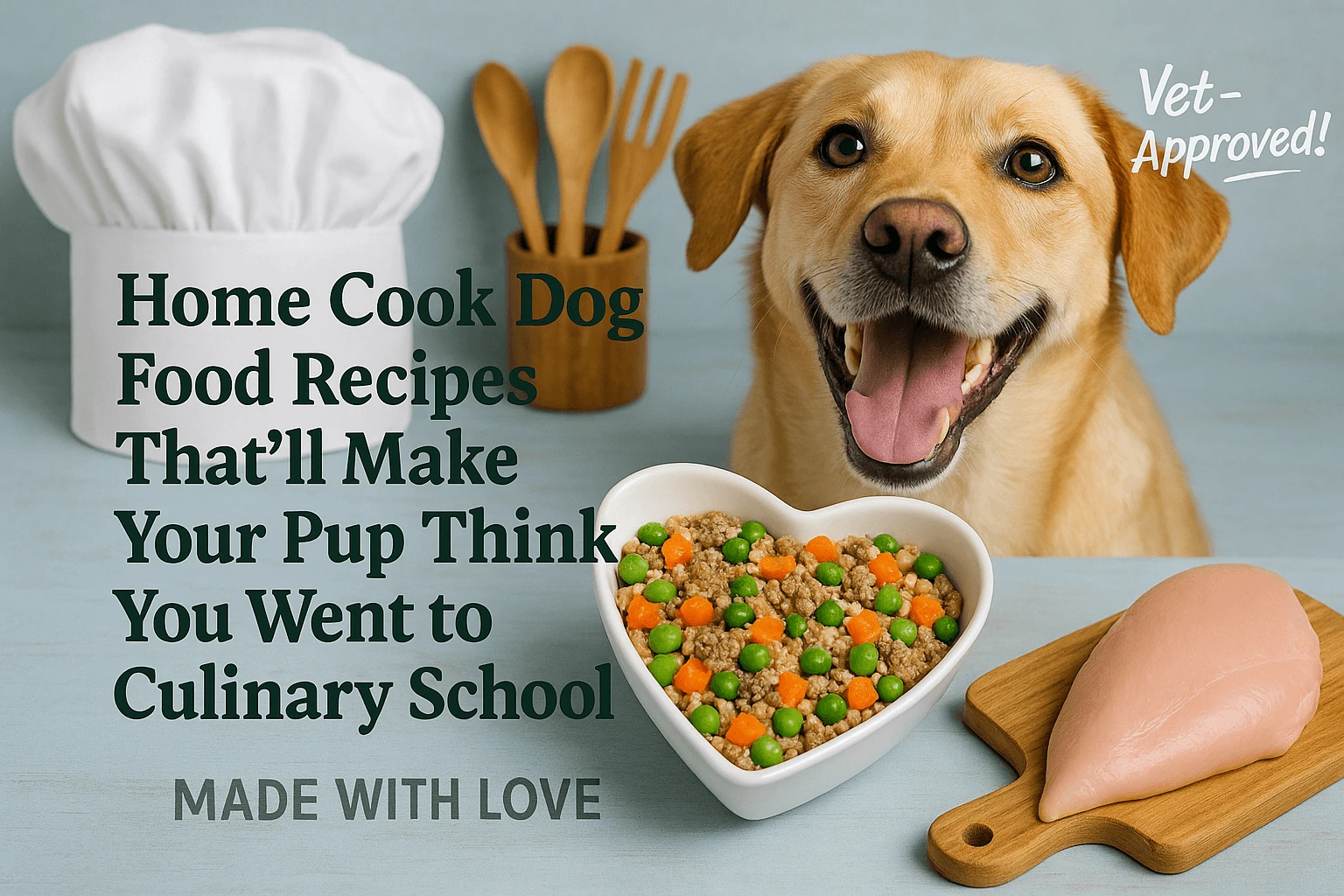
Home Cook Dog Food Recipes That’ll Make Your Pup Think You Went to Culinary School
Are you tired of pouring the same old dry brown pebbles into your dog’s bowl, only to get a look that says, “Seriously? This again?” It’s time to level up from kibble fatigue and enter the world of home-cooked dog food—a magical place where your pup’s meals are fresh, flavorful, and actually made from real food. Yes, food you can pronounce. Yes, food that smells good even to you.
In this ultimate guide to Home Cook Dog Food Recipes, we’ll show you how to transform your kitchen into your dog’s favorite restaurant (minus the tipping). Whether you’re looking to improve your pup’s digestion, boost their energy, reduce allergies, or just feel like the pet parent of the year, home cooking gives you full control over every ingredient in the bowl.
You’ll learn:
-
Why gently cooked food is the Goldilocks of doggy diets
-
Which ingredients are canine-approved (and which to avoid like that forgotten Tupperware in your fridge)
-
How to build balanced meals with the right protein, carbs, fat, and vitamins
-
How to batch prep, store, and serve without turning your kitchen into a science lab
-
And of course, how to make recipes so good, your dog may finally stop begging at your dinner plate (but no promises)
From beginner basics to advanced bowl-building, we’ve got you covered. Get ready to whip up meals that nourish your pup’s body, delight their taste buds, and maybe even earn you a few tail-wagging standing ovations. Let’s get cooking!
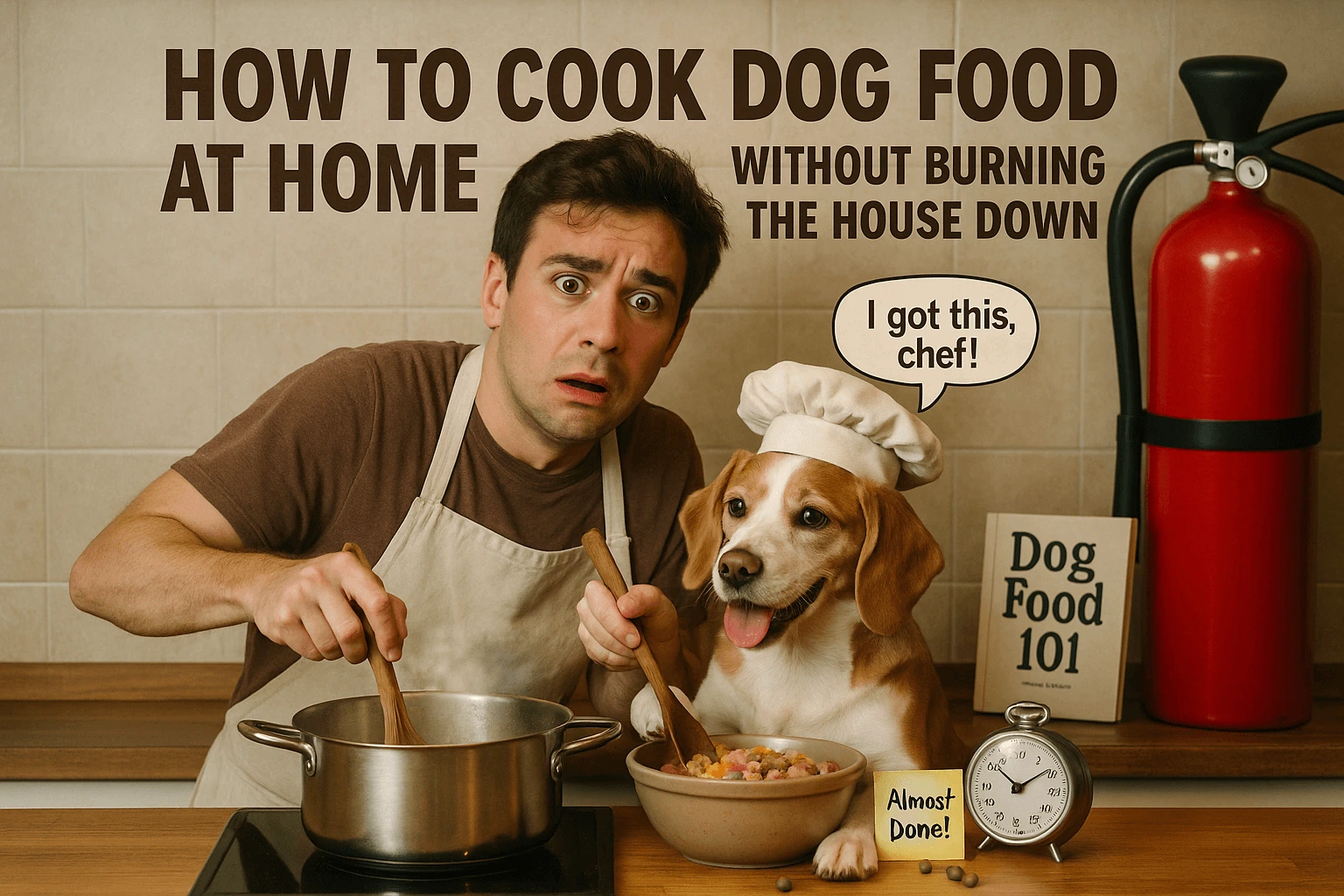
How to Cook Dog Food at Home Without Burning the House Down
So, you’ve decided to swap mystery kibble for something that actually smells like food. Bravo! You’re officially graduating from the School of Suspicious Pellets to the Academy of Real Food. Cooking dog food at home isn’t about gourmet Instagram posts or opening a pet cafe (although now that we’ve said it… tempting, right?). It’s about using simple, real ingredients to support your dog’s long-term health—while avoiding the unpronounceable stuff that sounds like it came out of a science fair experiment.
Cook Dog Food at Home Like a Boss (Chef’s Hat Optional)
Think of this as your pup’s five-star dining experience—except you’re the chef, they’re licking the plate (and the floor), and your sous-chef is a squirrel outside the window. Home-cooked dog food gives you the ultimate power move: control. Control over ingredients, nutrients, flavor, and whether or not your dog is getting another dose of “poultry by-product meal.” Spoiler: they won’t be. What they will be getting is food that’s rich in real meat, wholesome veggies, and carbs that fuel zoomies without mystery side effects.
You’re not just cooking a meal—you’re building your dog’s health from the bowl up. And yes, chef, your kitchen just became the hottest restaurant in town.
Cook Dog Food Recipe So Easy Even Your Dog Could Supervise
Here’s your fast-track recipe cheat sheet:
-
Pick your protein: Chicken, beef, turkey—basically whatever makes your pup’s nose twitch with anticipation. Bonus points if you sauté it lightly instead of boiling the life out of it.
-
Add veggies: Pumpkin, carrots, sweet potatoes—think colorful, crunchy, and full of fiber. Just steer clear of onions, garlic, and anything that sounds like it belongs in a vampire novel.
-
Toss in grains: Rice, oats, or quinoa (if your dog’s feeling bougie). These help round out the meal and give your dog that tail-wagging energy.
-
Cook it low and slow: Whether it’s in a Crock-Pot or a good ol’ pot on the stove, simmer everything until tender. The goal is “gently cooked,” not “soggy mystery stew.”
-
Cool it, portion it, store it: Let it cool completely, then divide into daily meals based on your dog’s weight and energy level. Store 3 days’ worth in the fridge, the rest in the freezer. Label them unless you like playing “Is this chicken for me or Charlie?”
Want to go gourmet? Add fish oil (for skin and coat), calcium (ground eggshell or supplement), and a dog-safe multivitamin. Voilà—you’re now officially that dog parent. And yes, your dog is now judging your own lunch by comparison.
Home Cook Dog Food Recipes Made Simple
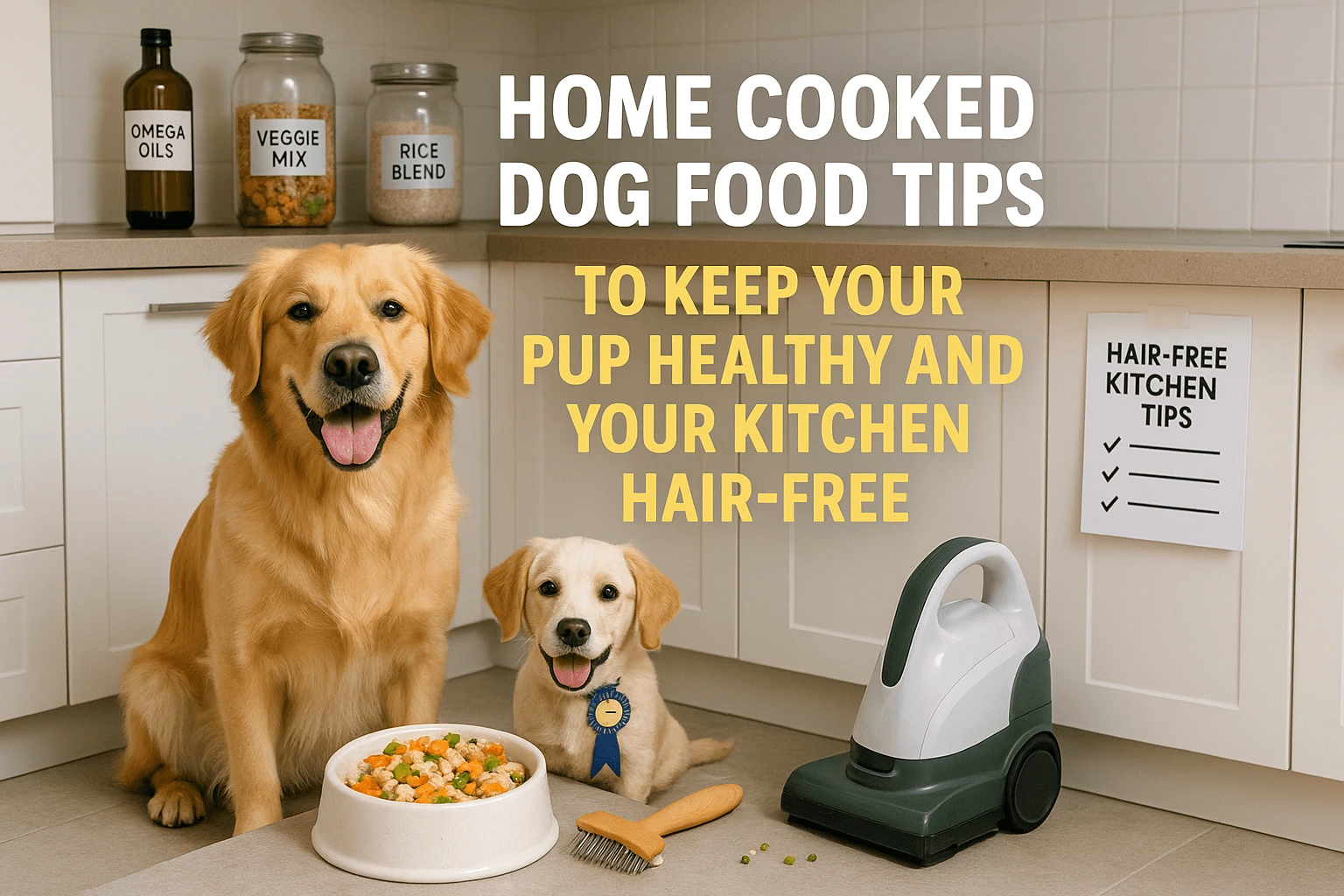
Home Cooked Dog Food Tips to Keep Your Pup Healthy and Your Kitchen Hair-Free
Cooking for your dog isn’t rocket science—unless your dog is a rocket, in which case you might want to check what’s in those treats. Still, it does take a bit of science, a lot of love, and maybe a podcast playing in the background to make it through your first batch without questioning your life choices. These tips are designed to help you dodge the rookie mistakes, nail the nutrition, and keep your kitchen from looking like a meat-splosion zone.
Cook Dog Food Without Losing Your Mind (or Your Measuring Cups)
Pro tip: dogs are not Gordon Ramsay—they won’t scream if the carrots are uneven or if the rice sticks. What they need is simplicity, consistency, and food that doesn’t resemble overcooked wallpaper paste. Use gentle cooking techniques like simmering or slow cooking. Avoid high heat, charring, or deep frying (save that for your cheat days, not theirs). Light sautéing in a touch of olive oil is fine, but we’re aiming for “nourish,” not “Michelin Star.”
Oh, and keep it bland—no salt, no onions, no spices. Your dog’s stomach is not built for chili flakes, no matter how much they beg with those big, manipulative eyes.
Cook Your Dog Food Like a Pro (Because You’re That Kind of Pet Parent)
Every dog is different—just like humans, but with more shedding. So their meals should match their needs:
-
Sensitive belly? Ditch dairy, wheat, and rich fats. Stick to lean meats and gentle carbs like rice or sweet potato.
-
Senior snacker? Think soft, mashable, and easy to gum. Slow-cooked stews and ground proteins are easier on older teeth and digestion.
-
Energetic athlete? Bring on the protein. Chicken thighs, turkey, and eggs help maintain lean muscle for all that squirrel-chasing.
Need an extra trick? Make big batches and freeze in silicone molds or reusable containers. You’ll save time, reduce mess, and your dog won’t even notice their gourmet meal came from the freezer. Bonus: you’ll feel like a meal-prep wizard. (Just don’t confuse it with your smoothie cubes.)
Try These Easy Home Cook Dog Food Recipes for a Healthier Pup
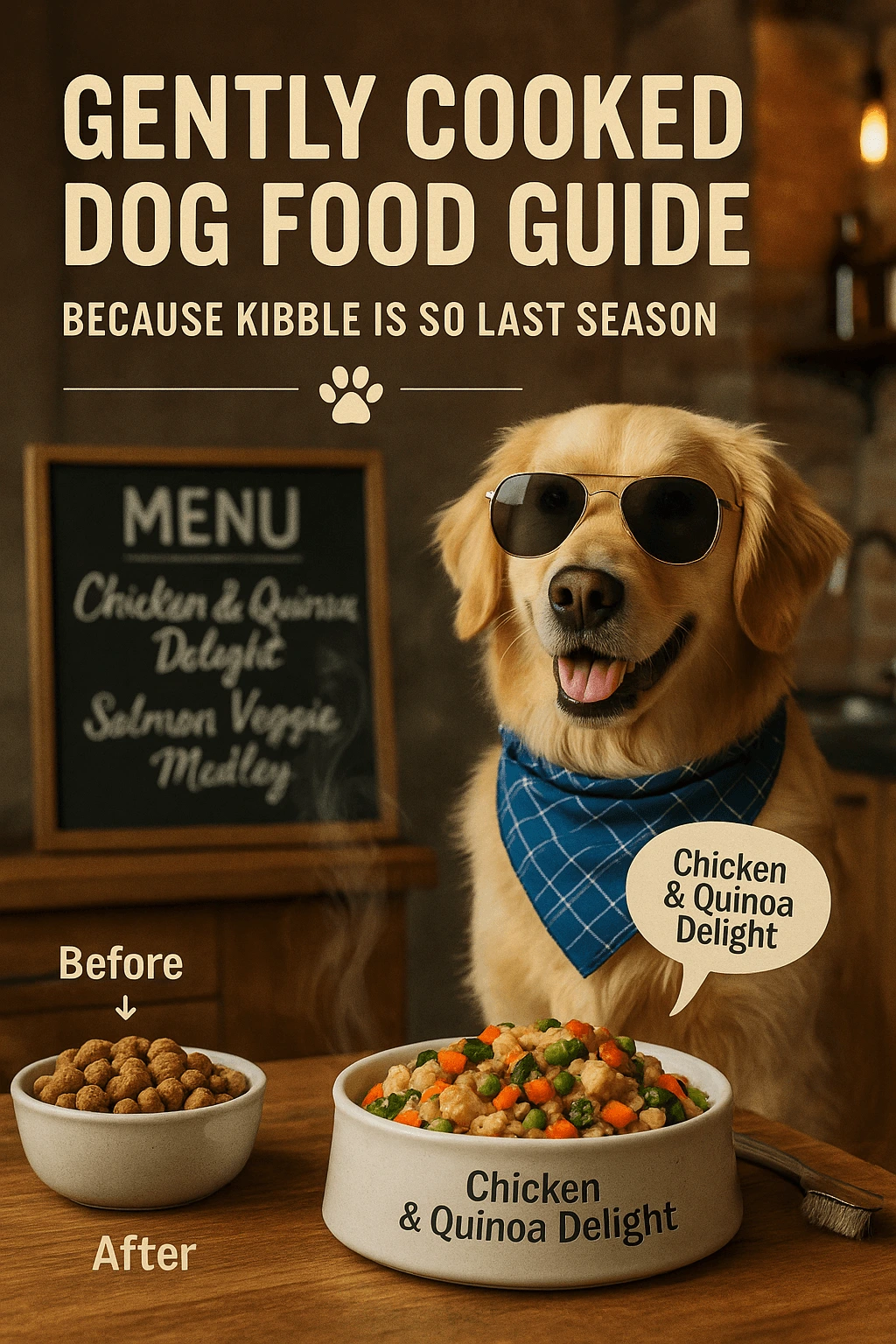
Gently Cooked Dog Food Guide: Because Kibble is So Last Season
Gently cooked dog food is the Goldilocks of canine cuisine—not too raw, not too dry, just right. It’s the perfect balance between the fresh, nutrient-dense appeal of raw food and the safety of cooked meals. The ingredients are lightly simmered or steamed, usually under 180°F, preserving vitamins and minerals while still zapping any unwanted bacteria that could cause your pup (and your carpet) problems.
This approach is ideal for pet parents who want the benefits of real, whole foods without the risks associated with raw diets. Plus, gently cooked meals tend to be easier to digest, which means fewer tummy troubles and way less time Googling “why is my dog’s poop orange.” It’s also a smart choice for picky eaters or dogs with sensitive stomachs.
In this section, we’ll show you how to embrace this middle ground with confidence—choosing the right ingredients, understanding cooking methods, and making sure the end result is both safe and tail-thumpingly delicious.
Gently Cooked Dog Food Brands That Don’t Smell Like a Science Experiment
If you’re not ready to go full Martha Stewart, gently cooked dog food brands are your new best friend. These pre-made meals are crafted by experts (and probably taste better than half the stuff in your freezer). They’re gently steamed or simmered, often in small batches, with fresh, human-grade ingredients—and they come balanced with all the essential vitamins and minerals so you don’t have to play doggy dietician after midnight.
Most reputable brands even consult veterinary nutritionists and publish their feeding guidelines clearly on the label. So instead of spending your night Googling things like “can dogs eat turmeric, basil, and quinoa all at once,” you can just grab a pouch, pour, and pat yourself on the back. Convenience? Check. Nutrition? Check. Happy dog? Double check.
Gently Cooked Dog Food Recipes That’ll Make Your Dog Drool (and Maybe You Too)
Want to impress your pooch and maybe your friends too? Try this (with a vet-approved calcium addition to keep those bones strong):
Chicken & Pumpkin Delight This gently cooked favorite is packed with protein, beta-carotene, fiber, and good fats. It’s easy on the tummy, great for the coat, and smells good enough that your neighbor might ask for a sample.
Ingredients:
- 2 lbs boneless, skinless chicken breast (diced or ground)
- 1 cup pure pumpkin puree (not the pie kind—no added sugar or spices)
- 1 cup finely chopped carrots
- 1 cup chopped green beans
- 1 cup cooked brown rice (cooled)
- 1 tbsp fish oil (or flaxseed oil for a plant-based option)
- 1/2 tsp ground eggshell powder per pound of food (or dog-safe calcium supplement)
Instructions:
1. In a large skillet or pot, cook the chicken over medium heat until no longer pink. Drain any excess fat.
2. Add the chopped veggies and about 1/2 cup of water or low-sodium chicken broth. Simmer on low for 10–15 minutes until veggies are tender.
3. Stir in the cooked rice, pumpkin puree, and fish oil. Mix thoroughly.
4. Let cool completely before adding the calcium supplement.
5. Portion into daily servings based on your dog’s weight (ask your vet if unsure!). Store in airtight containers for 3 days in the fridge or up to 3 months in the freezer.
Nutrition Tip: This dish balances lean protein with fiber-rich vegetables and complex carbs. The fish oil supports a healthy coat, while pumpkin and rice promote good digestion. Calcium ensures bone health—especially important if you’re skipping raw meaty bones.
Tail-wag guarantee: Your dog will love you more than your mailman. Possibly more than bacon. Possibly.
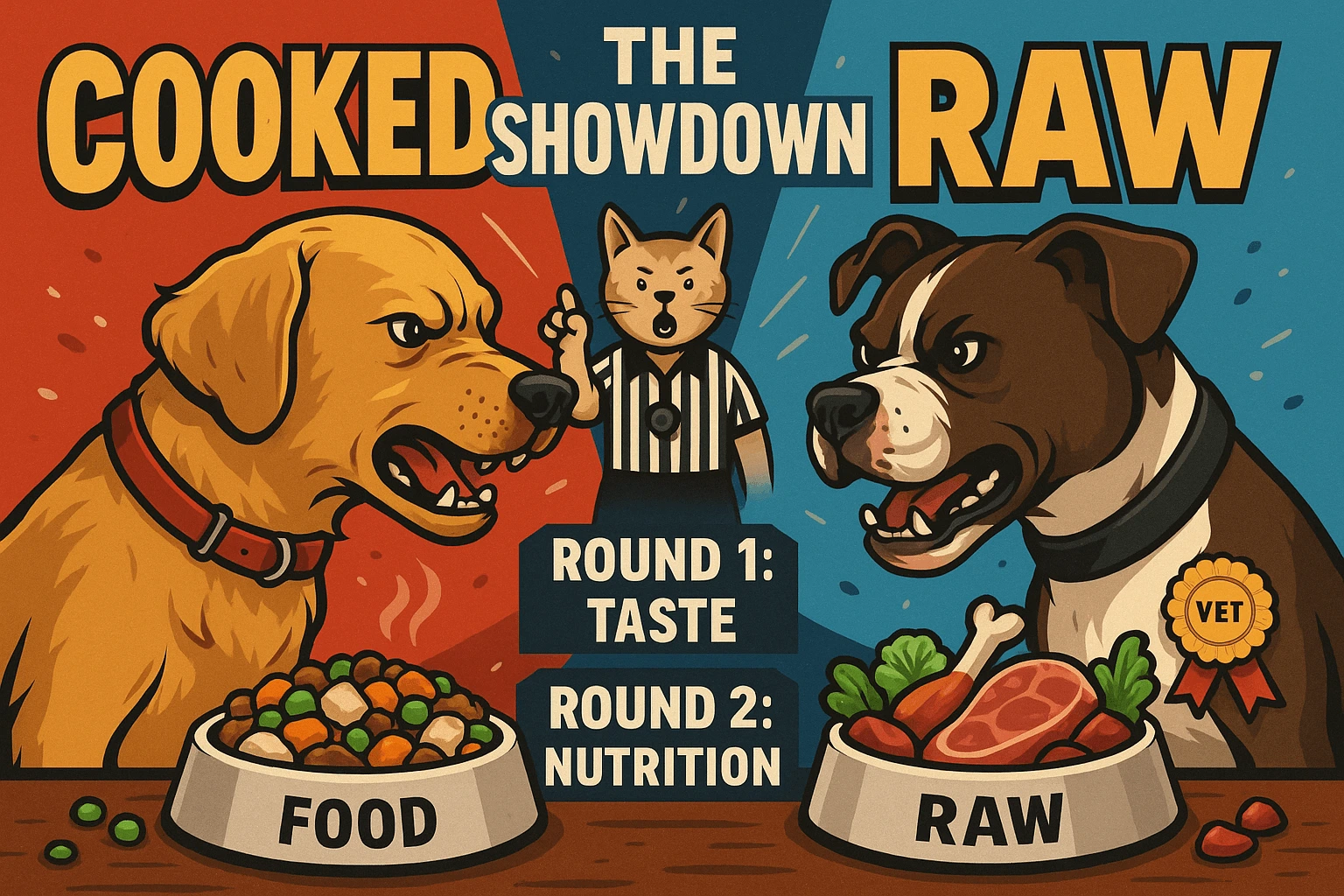
Cooked vs Raw Dog Food: The Showdown Your Dog Didn’t Know They Needed
Ah yes, the age-old debate: raw versus cooked. One side says ‘primal instinct,’ the other says ‘please don’t give my dog E. coli.’ It’s like the CrossFit vs. yoga of the dog world—both sides have passionate followers and compelling arguments. In this section, we break down the pros and cons of both, so you can choose what’s best for your furry friend (and your peace of mind).
Raw Dog Food Pros:
- Offers a diet closer to what wild canines eat
- Often praised for improving coat shine, dental health, and energy
- Can be beneficial for dogs with certain allergies
Raw Dog Food Cons:
- High risk of bacterial contamination (salmonella, listeria, etc.)
- Nutritional balance is tricky without expert guidance
- Can be dangerous for immunocompromised people in the household
Cooked Dog Food Pros:
- Safer from a foodborne illness standpoint
- Easier to digest for many dogs
- Nutrients are better preserved than with dry kibble when cooked gently
- More control over ingredients and dietary adjustments
Cooked Dog Food Cons:
- Still requires effort to maintain nutritional balance
- May lack some of the ‘raw’ enzymatic properties unless supplemented
- Dogs used to raw may resist the transition at first (but bribery with beef usually works)
Verdict: If you’re a beginner in the DIY dog food arena, gently cooked food is your safest, easiest bet. You get the benefits of freshness and customization without needing a microbiology lab. Raw diets can work, but only under the supervision of a vet or pet nutritionist who can help you balance nutrients and prevent any gnarly bacteria parties in your fridge.
When in doubt, think of your dog like a toddler: curious, messy, and not to be trusted with raw chicken.
Ah yes, the age-old debate: raw versus cooked. One side says ‘primal instinct,’ the other says ‘please don’t give my dog E. coli.’ In this section, we break down the pros and cons of both, so you can choose what’s best for your furry friend (and your peace of mind).
Raw food fans are intense—but let’s be honest, raw diets can be risky (hello salmonella, our unwanted kitchen guest). Gently cooked meals give you most of the nutrition without needing a hazmat suit or a biology degree.
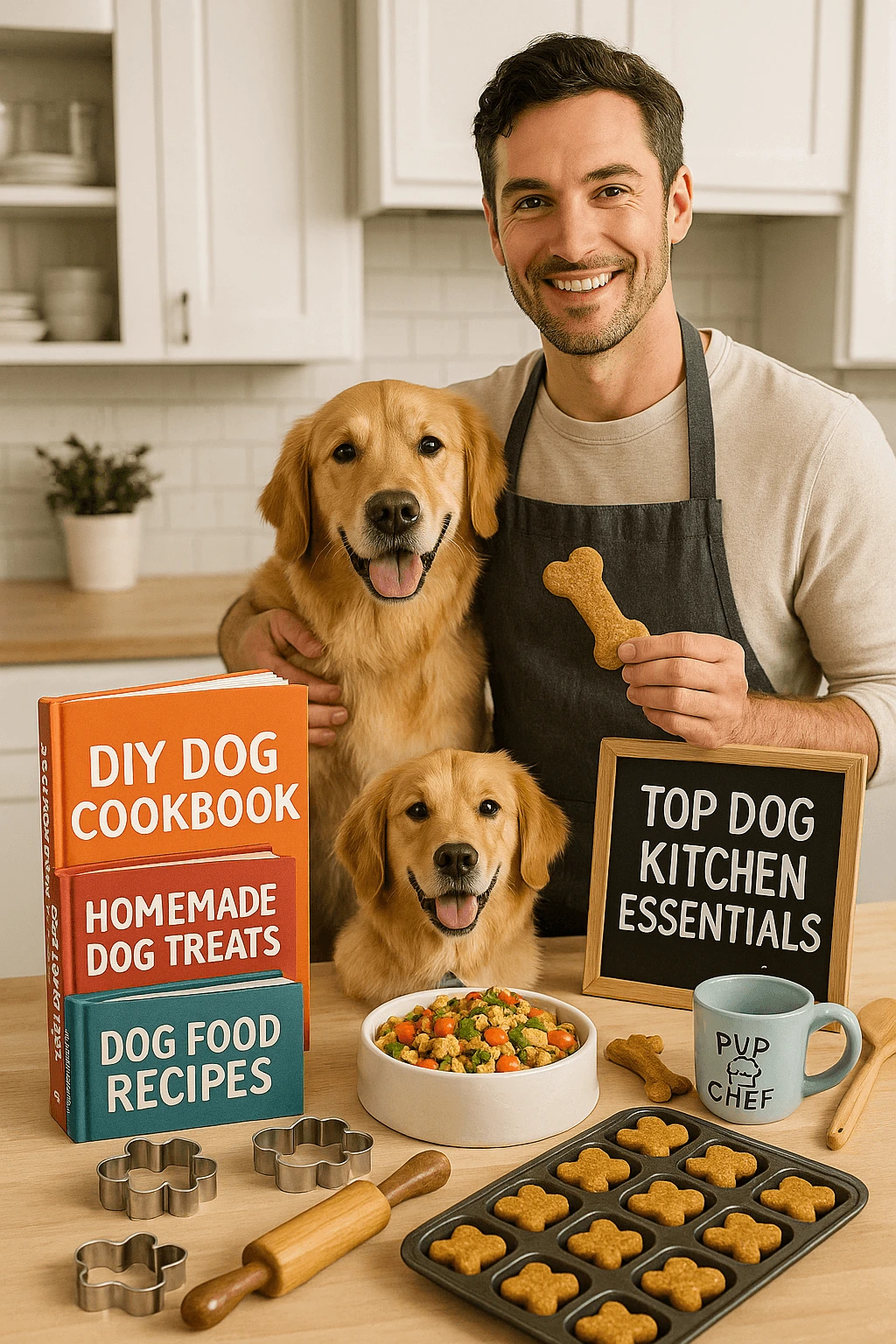
DIY Dog Cookbooks and Tools for the Dog Mom/Dad Who Has Everything
If Pinterest and your pantry had a baby, it’d look a lot like this section. Making your own dog food cookbook or toolkit isn’t just fun—it’s a lifesaver for those “what do I cook now?” moments. It brings structure to your kitchen chaos and helps you keep track of which meals your dog loved, which ones they buried in the backyard, and which ones caused suspicious farts at 3 a.m. Plus, it gives you a reason to buy more sticky notes and label everything like a nutrition-obsessed maniac (which, let’s face it, you are—and your dog is absolutely thriving because of it).
You don’t need to be a canine culinary wizard—just get a few basics:
-
Slow cooker: aka the magic cauldron that turns raw stuff into meaty magic while you scroll TikTok
-
Food scale: guesswork is adorable, but not when it results in vitamin deficiencies
-
Ice cube trays: perfect for small pups, portioning treats, or freezing bone broth and mini meatballs
-
Airtight containers: unless you want your fridge smelling like a crime scene
-
Measuring cups & spoons: because “some” is not a measurement
-
Recipe cards or digital templates: record the hits, learn from the flops, and keep track of portions
-
Freezer labels and markers: because “orange blob #2” is not helpful in a rush
-
A binder with tabs: organize by protein source, prep time, or even seasonal recipes (yes, pumpkin spice included)
Bonus points: Print out your dog’s favorite recipes and build your own “Bark Bistro Binder.” Add tabs, doodles, nutrition notes, and maybe even a goofy chef’s photo of your pup wearing an apron. Congratulations—you’re now that dog parent. And we love that for you.
Pro tip: If you’re feeling extra, laminate the recipes. Nothing says dedication like dog food flashcards that survive gravy splashes, muddy paws, and an accidental trip through the dishwasher.
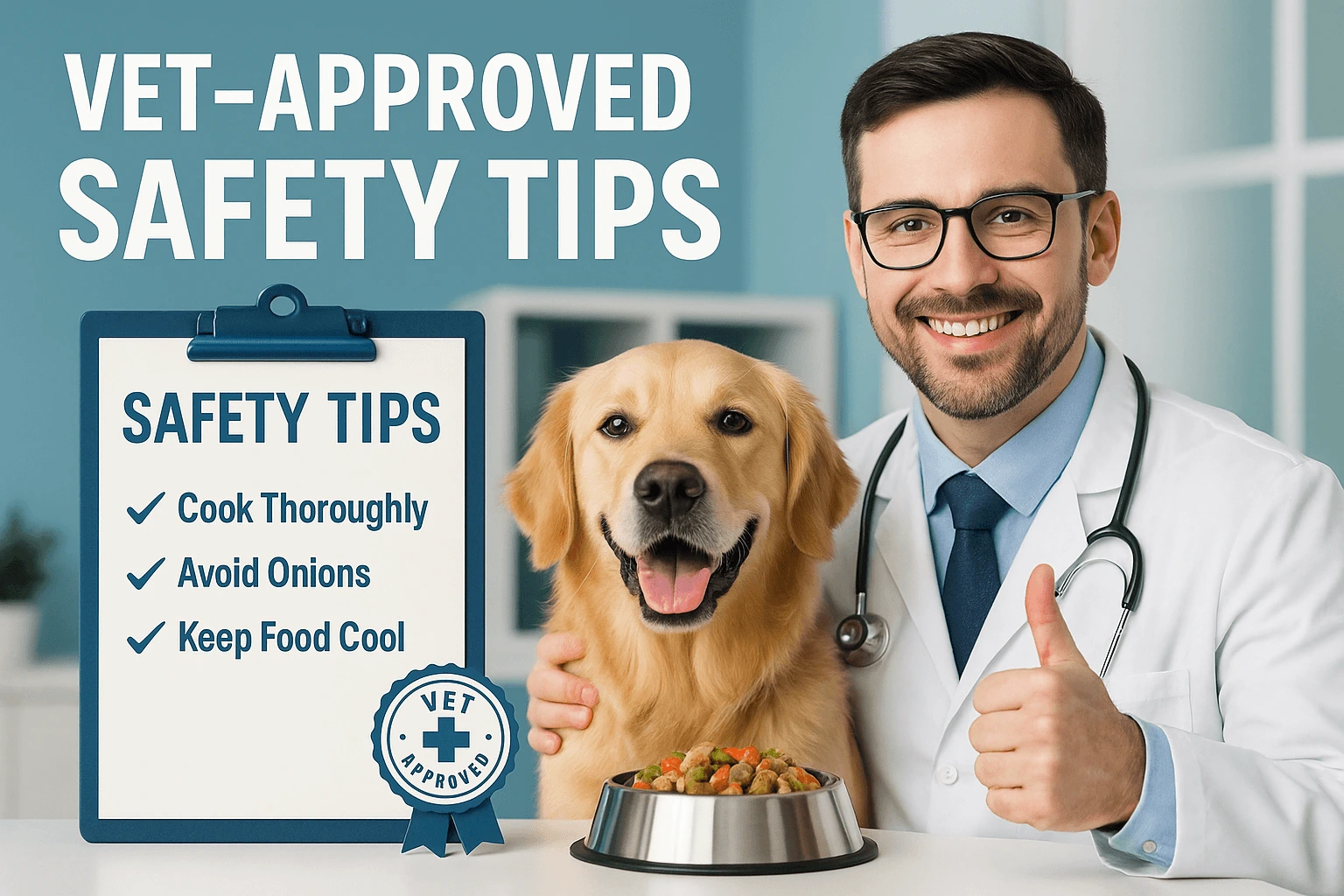
Vet-Approved Safety Tips
Before diving paw-first into home cooking, remember:
- Before diving paw-first into home cooking, remember:
- Always consult your vet or a board-certified veterinary nutritionist before switching your dog’s diet—especially if they have medical conditions. A professional can help you ensure your homemade meals are complete and balanced, not just lovingly overcooked.
- Don’t skip calcium. Homemade diets without bone require calcium from sources like ground eggshell or supplements. A lack of calcium can lead to serious issues like weakened bones or fractures—definitely not on the menu.
- Watch for food sensitivities. If your pup starts itching, farting like a foghorn, licking their paws, or giving you side-eye after dinner, it might be time to revisit your ingredients. Food allergies or intolerances can pop up faster than a dog at the sound of a treat jar.
- Proper storage saves stomachs. Store food in airtight containers. Refrigerate for up to 3 days, and freeze portions for longer-term storage. Bacteria love a warm stew as much as your dog does—don’t let leftovers become leftovers-with-a-side-of-salmonella.
- Label and date everything. Use freezer-safe bags or containers and mark the date clearly. Your dog might not care if dinner’s from Tuesday or Thursday—but their tummy sure will.
- Transition slowly. If you’re switching from kibble to homemade meals, do it gradually over 5–7 days to avoid digestive drama. A sudden switch could turn your carpet into a war zone.
- Your dog depends on you to be their personal chef, dietician, and poop-monitoring life coach. So keep it clean, keep it smart, and keep those tails wagging!

Final Thoughts
Cooking dog food at home might sound extra, but it’s actually easy, economical, and full of love (and yes, a little fur). Once you see your pup go nuts for your homemade chow, you’ll never look at kibble the same way again. You’ll start noticing your dog is more energetic, their coat shinier, and their poop… well, let’s just say easier to scoop and a whole lot less mysterious.
Homemade meals let you bond with your pup in a whole new way. You’re not just feeding them—you’re nourishing them with meals crafted by someone who knows exactly what goes into every bite. You become their chef, their hero, their holistic health guru—and possibly their new favorite family member (sorry, kids).
Let’s recap what we’ve covered:
-
We showed you how to actually cook dog food at home without setting off the smoke alarm.
-
We broke down what gently cooked means (basically: steamed, safe, and still tasty).
-
You learned how to prep balanced meals and store them like a pro.
-
We even gave you recipes that’ll have your dog drooling and possibly rating you 5 paws on BarkAdvisor.
-
You explored the pros and cons of raw vs. cooked food, so you can choose what works best for your pup.
-
And we gave you the tools (literally) to build a DIY dog food station Martha Stewart would envy.
So grab your spatula, channel your inner chef, and let’s get that tail waggin’. Play your favorite tunes, wear that apron with the paw prints, and make cooking part of your self-care too. If your dog starts requesting seconds, you’re doing it right. And if they bring their bowl to you with “the look,” well, congratulations—you’ve officially won at dog parenting.
Share your pup’s reaction (and your victory dance) in the comments below! Bonus points if you include a photo of your dog licking the bowl clean like it owes them money—and double bonus if you’ve laminated your recipe cards like the dog-food rockstar you are.
References
- American Kennel Club. “Making Dog Food at Home: Tips & Guidelines.” https://www.akc.org
- PetMD. “How to Make Homemade Dog Food.” https://www.petmd.com
- WSAVA Global Nutrition Committee. “Guidelines on Selecting Pet Foods.”
- Tufts University – Cummings Veterinary Medical Center. “Homemade Pet Diets.”
- NRC. “Nutrient Requirements of Dogs and Cats.”

Ready to Feed Your Dog Better, One Meal at a Time?
Grab your copy of The A-to-Z Cookbook to Healthy Homemade Dog Food and start cooking nutritious, tail-wagging meals today. Your fur baby deserves it.
People Also Ask
Q: How to cook dog food?
A: First, channel your inner dog chef—no need for a toque, just a big spoon and a bigger heart. Toss lean meats (like chicken or turkey) into a pot, add dog-safe veggies (carrots, green beans, pumpkin), stir in a healthy grain (rice, oats), and cook it low and slow. Cool it, portion it, and sprinkle in love (and calcium, seriously—don’t skip it).
Q: What are the best ingredients for homemade dog food?
A: Think of your dog’s bowl like a power smoothie in stew form. Best ingredients?
- Lean proteins (chicken, beef, turkey—no “mystery meat surprise”)
- Fiber-rich veggies (pumpkin, carrots, spinach—yes, greens!)
- Wholesome carbs (brown rice, oats, quinoa if you’re fancy)
- Supplements like calcium and fish oil (aka shiny coat in a bottle)
If it wouldn’t go in your grandma’s stew, it doesn’t go in the bowl.
Q: What is gently cooked dog food?
A: It’s like sous vide for your schnauzer. Gently cooked means food is lightly simmered or steamed—warm enough to kill bacteria, but low enough to keep nutrients intact. It’s the Goldilocks of dog cuisine: not raw, not overcooked, just right.
Q: Is cooked food good for dogs?
A: Oh yes, when it’s done right. Properly cooked food is easier to digest, safer than raw, and fresher than that 17-syllable ingredient kibble. Just remember—it’s only “good” if it’s balanced. Translation? No “chicken-only diet” unless you want your vet to raise an eyebrow.
Q: What is better for dogs: raw or cooked food?
A: Depends on your vibe. Raw is the wild side—nutrient-rich, but risky. Cooked is the comfort zone—gentler on digestion and safer for everyone involved. Unless you’re into playing salmonella roulette, gently cooked food is the beginner-friendly winner.
Q: What should top 3 ingredients be in dog food?
A: Let’s keep it real:
- Named meat protein (like chicken or beef, not “animal by-product mystery mulch”)
- Whole veggies (carrots, spinach, pumpkin—think farmer’s market, not vending machine)
- Healthy carbs or fats (brown rice or fish oil = tail-wag fuel)
Bonus if you recognize everything on the label without needing a Google search.
Q: Can I cook dog food with olive oil?
A: A little drizzle? Yes. A Paula Deen-level pour? Please no. Olive oil adds healthy fats and antioxidants, but use sparingly—about 1 tsp per 20 pounds of pup. Too much oil = turbo zoomies and toilet trauma.
Q: Can you cook dog food?
A: Not only can you, you should! Homemade dog food gives you control, freshness, and a reason to use that slow cooker collecting dust. Just follow a complete recipe and talk to your vet before you play Iron Chef: Canine Edition.
Q: What oil to cook dog food in?
A: Think clean and lean:
- Olive oil (great for the heart)
- Coconut oil (anti-inflammatory, but go light!)
- Flaxseed oil (add after cooking—it’s delicate, like your dog’s mood when you’re out of treats)
Avoid canola, bacon grease, or anything labeled “for industrial fryers.”
Q: What does cooked dog taste like?
A: If you mean dog food—think plain chicken stew with pumpkin and no salt. If you meant the other thing… buddy, you’ve got the wrong cookbook and we’re calling your dog for backup.
Q: What should be the number 1 ingredient in dog food?
A: Real meat. First. Always. No “corn,” “soybean meal,” or “beef-ish essence.” If it doesn’t start with a clear animal protein, it’s like a donut labeled “kale” because it sat near one once.


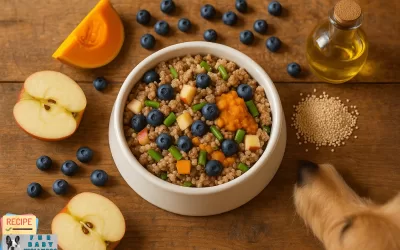

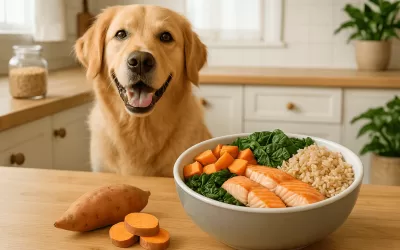



















0 Comments